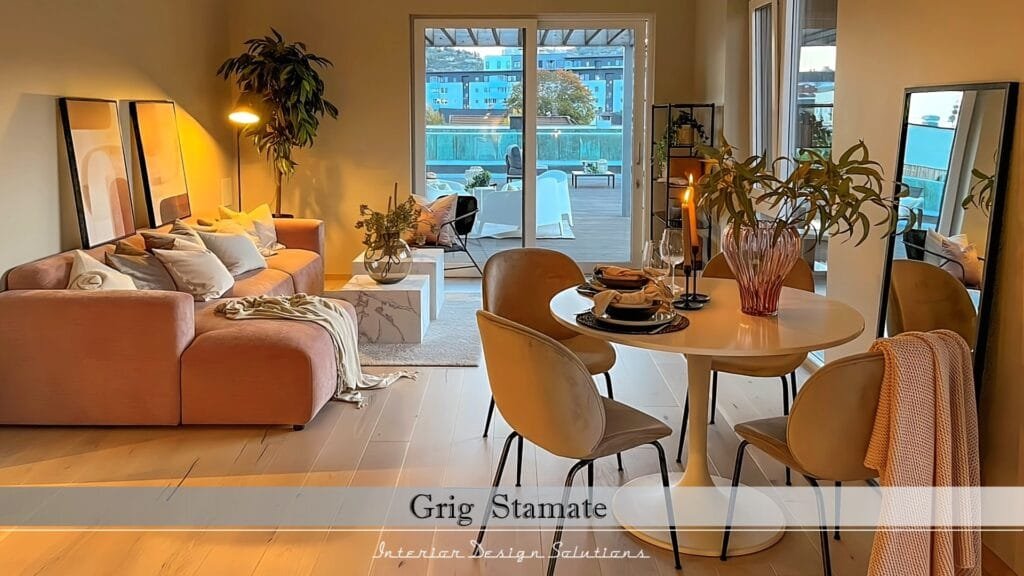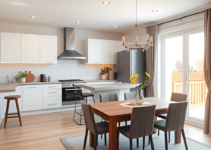Discover effective strategies for optimizing small living and dining areas with multifunctional furniture, creative storage solutions, and inspirational design ideas. Learn how to create a harmonious and inviting home with practical tips on maximizing space, incorporating personal touches, and embracing natural elements. From using light color schemes to introducing cozy lighting, explore ways to enhance your living environment while reflecting your personal style. Elevate your compact spaces into serene and stylish havens that maximize functionality without compromising aesthetics.
Exploring Multifunctional Furniture
In the realm of small living and dining areas, multifunctional furniture emerges as a crucial ally. This innovative approach to furniture design allows homeowners to optimize limited space while maintaining an aesthetically pleasing environment. The variety of multifunctional pieces available today caters to different needs, combining utility and style seamlessly.

Sofa beds are one of the most popular examples of multifunctional furniture. By day, they serve as comfortable seating for relaxation or socializing. By night, they transform into a cozy bed, accommodating overnight guests without the need for an additional bedroom. Investing in a quality sofa bed can significantly enhance the versatility of your space, offering both comfort and style.
Please read our article watch the newly uploaded video from our YouTube channel:
“Grig Stamate – Interior Design Solutions”
https://www.youtube.com/@GrigStamate
50 Best Small Living/Dining Areas: Design, Trends, and Inspiration #2 (video)
Here, you can see other related videos from our channel:
50 Best Small Living/Dining Areas: Design, Trends, and Inspiration (video) (video)
Open Spaces: 65 Unified Decor Ideas for Living/Dining Areas (video)
Another functional piece to consider is the extendable dining table. These tables can be adjusted in size to comfortably fit both small family dinners and larger gatherings. When not in use, they can be compacted to save space, making them ideal for smaller areas where every square foot counts. This adaptability ensures that you can host various occasions without additional constraints.
Ottomans that offer built-in storage are also valuable in small living spaces. They serve dual purposes, acting as both seating and a place to organize items, such as blankets or books. This can help to keep your living area tidy and free of clutter, making it more inviting and functional.
When choosing multifunctional furniture for small living or dining spaces, it’s essential to prioritize quality and design. Look for pieces that complement your existing decor while ensuring they fulfill multiple roles. By thoughtfully selecting furniture, you can create a harmonious environment that reflects your lifestyle and effectively utilizes available space.
Color Schemes That Open Up Spaces
In the design of small living and dining areas, color plays a pivotal role in creating the illusion of spaciousness. The psychology of color suggests that lighter hues tend to evoke a sense of openness and airiness. A palette dominated by soft shades like whites, creams, and pastel tones can reflect light and make a room feel larger and less constricted. When seeking to maximize the perceived space in a small area, these lighter colors become indispensable tools in the designer’s arsenal.
Moreover, integrating color accents can further enhance this effect. For instance, incorporating vibrant accent colors through accessories such as throw pillows, artwork, or decorative elements can add visual interest without overwhelming the space. These pops of color serve as focal points, drawing the eye away from the room’s limitations and toward the carefully curated decor. Anecdotal evidence suggests that an artist’s choice of a bold blue or rich green in a room showcasing predominantly light shades can significantly alter the overall ambiance, making it feel dynamic yet coherent.
Additionally, the use of color can be influenced by the practical needs of the inhabitants. For example, if a small dining area is primarily used for entertaining guests, a warm palette featuring muted reds or yellows can invoke a cozy, inviting atmosphere. Conversely, cooler tones can create a more tranquil environment, ideal for relaxation. Ultimately, the choice of color scheme in small areas is not merely aesthetic; it is part of a broader narrative, enhancing the spatial experience while reflecting the personal tastes of those who inhabit it.
In conclusion, selecting the right color schemes can dramatically transform small living and dining spaces. By leveraging lighter colors and thoughtful accent choices, one can create an illusion of openness and elevate the overall design, resulting in a functional and inviting environment.
Creative Storage Solutions
In small living and dining areas, maximizing space is essential to maintain functionality without compromising style. Creative storage solutions are paramount for those seeking to enhance their living environment while minimizing clutter. Utilizing under-the-bed storage is an efficient way to take advantage of often-overlooked spaces. Drawers or bins designed to fit beneath the bed can house seasonal clothing, extra linens, or even books, keeping them accessible yet out of sight.
Wall-mounted shelves offer another innovative storage option for small spaces. These shelves can serve as both decorative elements and practical storage. By displaying books, plants, or decorative articles, they provide a visual appeal while freeing up valuable floor space. Moreover, floating shelves can be strategically arranged at different heights to create an eye-catching gallery-like display, catering to both storage needs and aesthetic preferences.
A particularly clever hack involves repurposing everyday items for storage. For instance, using vintage suitcases as side tables adds charm while providing ample hidden storage. Guests might admire the rustic aesthetic of the suitcase, but you benefit from the practicality it brings. Another popular approach is to incorporate multi-functional furniture; an ottoman that opens to reveal a hidden compartment can serve as additional seating while conveniently storing blankets or magazines.
Additionally, utilizing vertical space is key to optimizing small areas. Tall bookshelves can draw the eye upward, making the space feel larger while offering a solution for housing books and displaying decor. Incorporating hooks or pegboards on walls can also provide spots for hanging items, from kitchen utensils to hats, thereby maintaining a tidy appearance.
In summary, integrating creative storage solutions in small living and dining areas is not only practical but also enhances the overall aesthetic of the space. By utilizing under-the-bed options, wall-mounted shelves, and repurposed furniture, homeowners can cultivate a stylish yet organized environment. This approach not only maximizes space but also adheres to the contemporary design trends of minimalism and functionality.
Trendy Lighting Ideas for Cozy Ambiance
In small living and dining areas, the significance of lighting cannot be overstated. It plays a crucial role in enhancing the ambiance and functionality of these compact spaces. By strategically incorporating various lighting types, one can cultivate a cozy atmosphere that is both inviting and practical. Among the diverse lighting options available, pendant lights, wall sconces, and string lights stand out as effective choices.
Pendant lights are particularly beneficial in small dining areas. They not only offer direct illumination for dining but can also serve as statement pieces. A unique pendant light can become a focal point for the space, adding character and charm. For small living areas, it is advisable to select pendant lights with compact designs that do not overpower the room while still providing adequate lighting.
Wall sconces are another excellent choice for small spaces. They can be mounted at various heights, creating layers of light, which enhances the depth of a room. With an array of styles ranging from modern to vintage, wall sconces can complement the existing decor while providing functional lighting without consuming precious floor space. For instance, sconces placed on either side of a cozy reading nook can illuminate the area while adding to its charm.
String lights, often associated with outdoor settings, are increasingly becoming popular in interior designs, particularly for small living areas. Their versatility allows them to be draped creatively across walls or ceilings, providing a warm, diffused light. Additionally, these lights can evoke a sense of whimsy and character, especially when used in unexpected ways. Whether you opt for fairy lights that twinkle or broader decorative bulbs, they can significantly enhance the cozy ambiance.
Mixing and matching these lighting types can lead to a well-lit, inviting environment. By combining direct and ambient lighting sources, you create a cozy yet functional living and dining area, perfect for gatherings or quiet evenings at home.
Bringing Nature Indoors
In recent years, biophilic design has gained significant traction, emphasizing the connection between nature and our living spaces. Integrating natural elements into small living and dining areas not only enhances aesthetics but also promotes mental well-being. The presence of plants has been shown to uplift moods, reduce stress, and improve air quality, making it a worthwhile endeavor for homeowners seeking tranquility in compact settings.
For those venturing into the world of indoor plants, it is important to choose species that thrive in lower light conditions, especially in smaller spaces where sunlight may be limited. Some excellent options include the Snake Plant, which is renowned for its air-purifying qualities, and the Pothos, known for its trailing vines that can elegantly adorn shelves or window sills. Additionally, the Zamioculcas zamiifolia, or ZZ plant, offers a resilient choice with glossy leaves that can create a striking visual impact in corners of small living areas.
With an array of easy-care options available, displaying plants creatively can further enhance the indoor atmosphere. Wall-mounted planters or hanging pots not only save counter space but also draw the eye upward, creating the illusion of height in smaller rooms. Window boxes can serve as delightful accents, while terrariums can transform coffee tables into living art pieces. Also, grouping multiple plants together can establish a lively focal point, drawing attention and sparking conversation.
Ultimately, fostering a connection with nature through thoughtful plant choices and placements creates a soothing presence in our homes. As biophilic design continues to influence interior trends, integrating greenery into small living and dining spaces can transform them into serene havens, promoting a healthier and more harmonious environment.
Incorporating Personal Touches
Enhancing small living and dining areas with personal touches can significantly transform them from mere functional spaces into warm, inviting homes. Personalization allows individuals to express their identity and style, creating an ambiance that resonates with their experiences and memories. Decorating with artwork can be an excellent way to inject character into a small area. One might consider hanging vibrant paintings or photographs that tell a story, perhaps capturing family adventures or local scenes. A well-placed gallery wall can serve as a stunning focal point and conversation starter.
Another effective method of personalizing a space is through family photographs. Displaying cherished images in tasteful frames can evoke positive memories while contributing to a comforting atmosphere. Corner shelves or floating wall units can elegantly showcase these photographs without taking up valuable floor space, maintaining the room’s openness. In addition to visual elements, incorporating textiles with sentimental value—like handcrafted throws or cushions from travels—can add warmth and personal significance.
It is also worthwhile to consider the use of plants to enhance personal charm. Greenery not only connects one to nature, but specific plants can hold particular memories and associations, bringing a sense of nostalgia into the space. Small pots of succulents, hanging ferns, or even a herb garden can inject a breath of life into confined areas while ensuring that the design remains uncluttered. Balancing these personal elements with streamlined furniture choices is essential to prevent overwhelming small areas. The key lies in selecting pieces that reflect personality while ensuring they serve functional purposes without crowding the space.
Through thoughtful inclusion of art, photographs, textiles, and greenery, small living and dining areas can reflect the uniqueness of those who inhabit them, creating a cohesive and inviting home that feels distinctly personal.
Maximizing Vertical Space
In small living and dining areas, maximizing vertical space is essential to create an illusion of height and openness while efficiently utilizing limited square footage. Implementing strategic design elements can lead to a more spacious and organized environment. One effective approach is the use of tall bookshelves. These shelves not only provide ample storage but also draw the eye upwards, encouraging a perception of higher ceilings. Opt for designs that extend from floor to ceiling, thereby allowing room for decorative items, books, and plants. Such arrangements can transform a small space into a visually captivating area that balances both aesthetics and functionality.
Another method to enhance verticality is the installation of high-mounted cabinets. Utilizing the upper walls in a small dining area can free up essential floor space while maintaining practicality. Floating cabinets or shelves can house dinnerware, collectibles, or even kitchen essentials, serving dual purposes of decoration and storage. Furthermore, ensure that these cabinets are easily accessible to prevent awkward reaches, making daily use convenient.
In addition to shelves and cabinets, wall art serves as an effective tool to extend the visual verticality of a room. Consider hanging large pieces of art or a vertical gallery wall, as these arrangements will guide the eye upward and create a focal point that enhances the overall ambiance. Vertical mirrors can also play a pivotal role in reflecting light, further enhancing the spacious feeling of the area. By thoughtfully introducing elements that utilize vertical space, small living and dining areas can achieve an airy and expansive atmosphere, turning any compact space into a harmonious haven.
Embracing Minimalism in Design
The minimalist design philosophy has gained significant traction, particularly in small living and dining areas where space is at a premium. The essence of minimalism revolves around creating a curated environment that emphasizes functionality while reducing the clutter that often overwhelms these spaces. By prioritizing decluttering, individuals can foster a serene atmosphere that not only enhances the overall aesthetic but also promotes a sense of peace. This intentional approach to design allows for a more organized and streamlined living experience.
One of the fundamental principles of minimalism is the concept of “quality over quantity.” In small areas, every piece of furniture or decor should serve a purpose and contribute positively to the overall environment. Selecting timeless pieces that are both functional and stylish can effectively enhance the aesthetic without overcrowding the space. It is advisable to invest in high-quality items rather than succumbing to fast furniture trends that may not withstand the test of time. Each element should harmonize with others, creating a cohesive look that celebrates simplicity and elegance.
Furthermore, the minimalist approach encourages thoughtful decision-making regarding personal belongings. By adopting a mindset focused on essentials, individuals can significantly reduce the number of items in their living and dining areas. This not only maximizes available space but also draws attention to key pieces that truly resonate with one’s personal style. In doing so, small living areas can transform into peaceful retreats that are filled with intentional choices rather than unnecessary clutter, allowing for a more enjoyable and functional environment.
In summary, embracing minimalism in small living and dining areas offers numerous benefits, from creating an organized space to incorporating high-quality furnishings. This design philosophy not only enhances visual clarity but also leads to a more balanced and tranquil lifestyle.
Inspiration From Around the World
When it comes to designing small living and dining areas, drawing inspiration from various cultures can introduce unique perspectives and styles. One exemplary approach is the Japanese concept of zen design, which emphasizes simplicity, tranquility, and harmony with nature. The Japanese aesthetic often utilizes minimal furnishings and natural materials, creating a serene environment that feels unobtrusive. Incorporating sliding shoji screens or tatami mats can not only save space but also infuse your home with a sense of calm and focus.
Equally captivating is the Scandinavian design philosophy, which celebrates functionality combined with beauty. Known for its light color palettes and clean lines, Scandinavian interiors often feature multifunctional furniture that maximizes utility without sacrificing aesthetics. Wood elements, bright whites, and soft textiles are prevalent, crafting a cozy yet stylish ambiance. By selecting a small dining table with built-in storage or using wall-mounted shelves, homeowners can optimize their spaces while maintaining the airy, open feel that is characteristic of this design trend.
In contrast, Mediterranean style introduces vibrant colors and intricate patterns that can warm up small spaces. Think vivid tiles, rustic wood beams, and plenty of natural light. This rich aesthetic can be translated into a cozy dining area by adding colorful tableware, textured cushions, and earthy decorative items, creating an inviting atmosphere that encourages social gatherings.
Furthermore, Moroccan design, with its bold colors and ornate furnishings, can be adapted in smaller settings to create a rich, inviting space. Incorporating poufs, lanterns, and patterned textiles can imbue small areas with character, creating a charming nook without overwhelming the senses.
As one explores these global design styles, it’s essential to consider practical elements, ensuring that the charm of these diverse traditions translates into an efficient and appealing small living or dining area.
Other related posts from our website:
Let’s see here, three of them:
https://howtobuildahouseblog.com/stunning-living-dining-areas-open-spaces-you-must-see/
https://howtobuildahouseblog.com/the-50-most-popular-living-dining-rooms-of-2024-open-space-layouts/
https://howtobuildahouseblog.com/small-spaces-combined-living-dining-room-design-ideas/
Thank you so much for your attention.
We also sincerely hope you like our ideas from this post, and you have also enjoyed our uploaded YouTube video.
See you next time at another article. Thank you so much for your time. Bye now!


